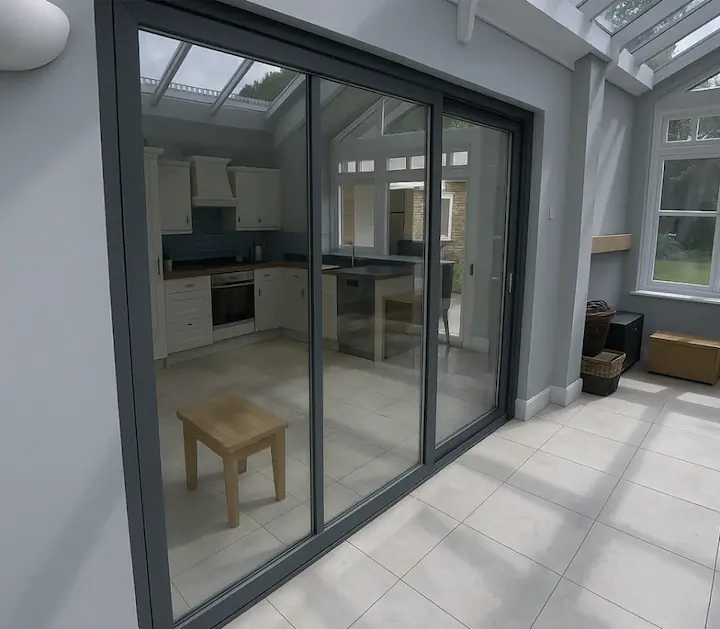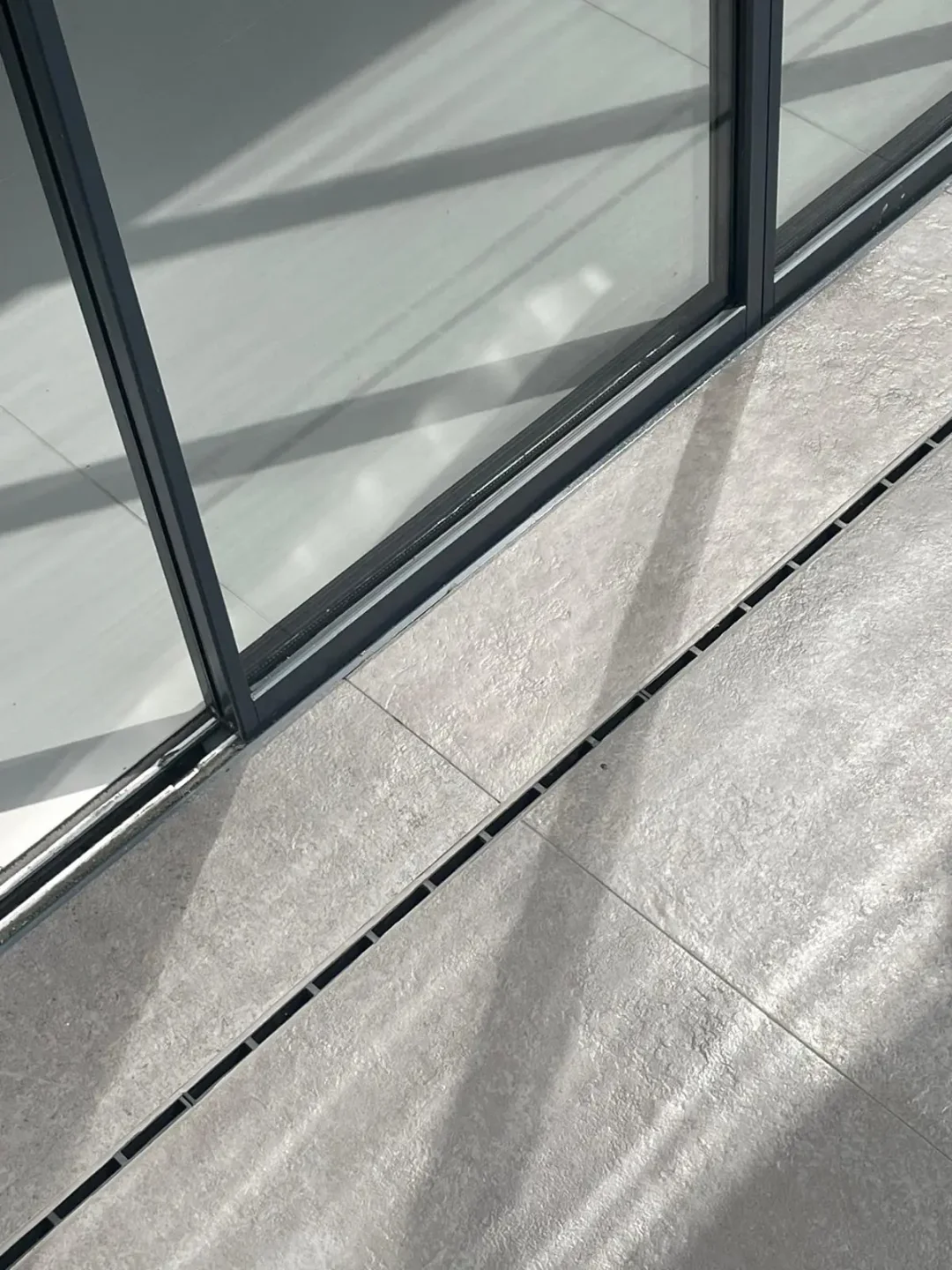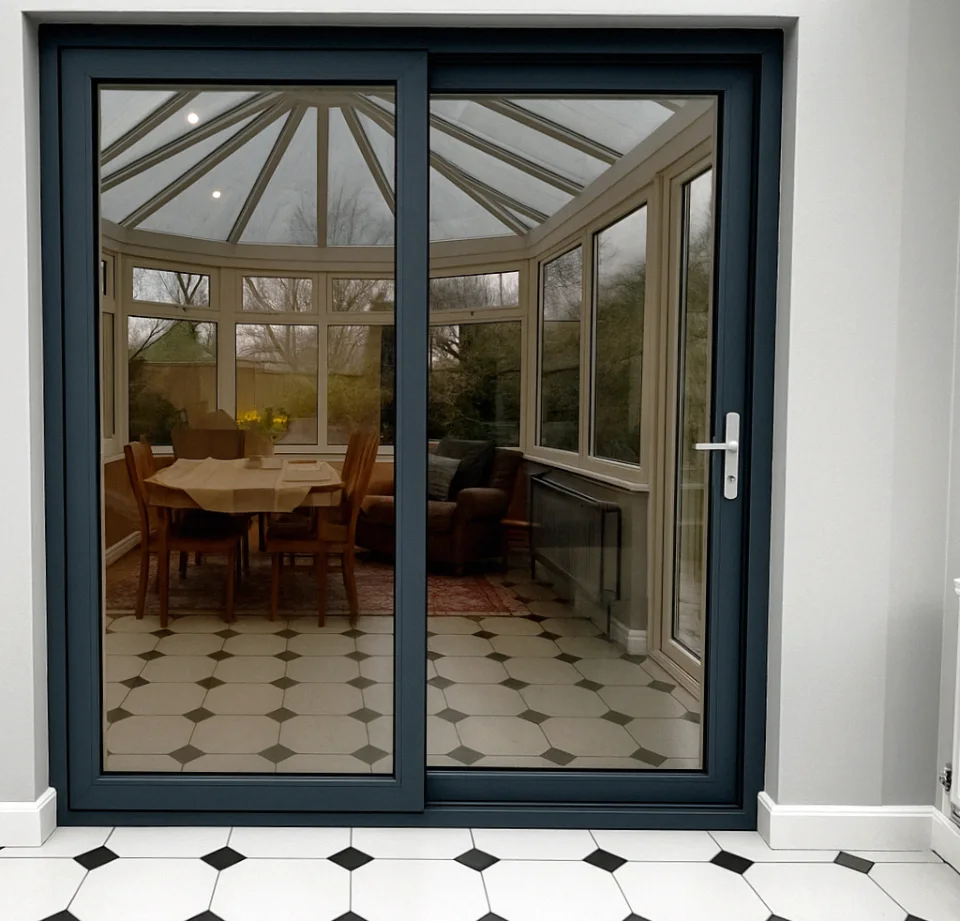Grey Internal Sliding Doors: Design & Style Guide
Table of Contents

Grey Internal Sliding Doors and Room Psychology
The way a room makes you feel stems directly from its core design elements, with grey internal sliding doors creating spaces that promote relaxation and focus, when used effectively.
Creating Calm Living Spaces
Soft grey tones absorb and diffuse light rather than reflecting it harshly like white doors, helping to reduce visual stimulation in busy areas. Mid-grey sliding doors naturally draw the eye without dominating the space, letting other design elements shine while maintaining visual harmony. People often report feeling more settled in rooms featuring anthracite grey sliding doors, for example, as darker shades help anchor the space and provide a sense of groundedness.
The Balance Between Black and White
Moving away from stark extremes, grey doors strike an ideal middle ground between oppressive black and clinical white. Light greys bring warmth that pure white lacks, while stopping short of the heaviness that black introduces to a room. The subtle variations in grey pigments create depth without overwhelming the senses, allowing your brain to process the space more comfortably.

Impact on Room Size and Light
Light bounces differently off grey surfaces compared to white or black, creating subtle shadows that add dimension to flat walls. Pale grey sliding doors reflect enough light to keep spaces bright while reducing glare, particularly valuable in south-facing rooms. Glass kitchen doors in grey tints filter natural light beautifully, maintaining brightness while softening harsh sunlight.
The human eye perceives grey differently depending on surrounding colours and lighting conditions. Morning light brings out warm undertones in grey doors, while evening light emphasises cooler blue notes, naturally shifting the room’s character throughout the day. North-facing spaces particularly benefit from lighter grey doors, which help maintain brightness without creating the stark contrasts that white doors produce.
Choosing the Perfect Grey Shade for Grey Internal Sliding Doors
Selecting the right tone makes all the difference when buying internal grey sliding doors, with each shade creating distinct moods and visual effects in your space.
How Natural Light Changes Grey
Morning sunlight brings warmth to grey internal sliding doors, while afternoon light reveals different characteristics entirely. Grey aluminium sliding doors often appear different colours throughout the day, thanks to their metallic undertones reflecting changing light conditions.
The position of artificial lighting matters just as much as natural light. Spotlights aimed directly at grey interior sliding doors create shadows and depth, while diffused lighting smooths out the surface appearance. Wall-mounted lights placed near grey internal sliding doors can either soften or sharpen their appearance, depending on the bulb temperature and positioning.
Light Temperature Effects
Cool-white LEDs pull out blue undertones in grey doors, creating a modern, crisp look. Warm lighting brings forward any taupe or brown undertones, producing a cosier atmosphere. The interplay between light sources requires careful planning – mixing different bulb temperatures can make grey internal sliding doors appear inconsistent or patchy.
Surface Finishes and Textures
Matt finishes absorb light evenly across the surface, creating a sophisticated, understated look that works particularly well in contemporary spaces. Textured surfaces add visual interest while hiding fingerprints and minor scratches – ideal for high-traffic areas between living spaces.
Powder-coated finishes offer excellent durability and colour consistency, maintaining their appearance even in spaces with changing humidity levels. Metallic grey finishes create subtle variations as light moves across the surface, adding movement and interest to otherwise plain doors.

Matching Hardware and Handles
Brushed steel handles complement cool greys perfectly, while brass or copper hardware brings warmth to neutral grey tones. Black hardware creates sharp contrast against lighter greys but blends smoothly with charcoal shades. The size of door furniture matters too – substantial handles make a statement against pale grey, while minimal hardware lets darker shades command attention.
Flush handles maintain clean lines and suit contemporary spaces, particularly when matched to the door’s finish. Edge pulls in contrasting metals can highlight the sliding mechanism while adding visual interest to the overall design. Track systems visible above the door should match or purposefully contrast with the chosen hardware to create a cohesive look.
Coordinating with Fixed Elements
Room features like skirting boards, coving, and window frames need careful coordination with grey doors. Pure white architectural elements can look stark against warm greys but pair beautifully with cooler tones. Natural wood maintains its character while working harmoniously with most grey shades, thanks to the neutral nature of grey itself.
Wall colours surrounding the doors play a big part in the final look. Deep charcoal doors pop against pale walls but risk overwhelming darker wall colours. Lighter grey doors offer more flexibility, working well with bold wall colours without competing for attention.
Grey Internal Sliding Doors in Room Design
Rooms take on different personalities depending on how you style grey internal sliding doors within the wider design scheme.
Modern Rustic Combinations
Natural wood flooring creates a beautiful foundation for grey internal sliding doors, especially when the wood grain shows through a white-wash or light stain. Oak floorboards in particular complement mid-tone greys, their warm undertones balancing the coolness of the doors. Space saving sliding doors offer practical advantages while maintaining this aesthetic harmony – the clean lines of grey doors offset rustic elements without competing with them.
Raw brick walls paired with grey interior sliding doors strike an impressive balance between industrial and homely. The texture of exposed brick provides a perfect backdrop, especially when the mortar colour picks up similar tones to the doors. Adding wooden furniture and natural textiles softens the overall look, preventing the space from feeling too stark or clinical.
Stone flooring requires careful matching with door shades – slate greys need doors in slightly lighter tones to prevent the space from feeling heavy. Terracotta or limestone flooring creates an interesting contrast with grey internal sliding doors, the warm floor tones lifting cooler grey shades above.
Industrial Style Applications
Metal accents make powerful statements alongside grey doors, particularly when using darker anthracite shades. Black steel light fittings and curtain poles create coherent lines through the space, while copper or brass elements add warmth without compromising the industrial aesthetic.
Polished concrete floors provide an ideal base for this style, their subtle variations echoing the tones in grey sliding doors. The key lies in layering different grey materials – matt door finishes against glossy floors, or textured walls against smooth door surfaces create depth without cluttering the visual field.
Monochromatic Room Schemes
Building a grey palette requires attention to undertones – warm and cool greys can clash if mixed without purpose. Starting with grey internal sliding doors as the mid-tone anchor point allows you to work lighter and darker shades around them effectively. Wall colours should sit at least two shades apart from the doors to create definition and prevent the space from appearing flat.
Textiles play an essential part in monochromatic schemes. Wool throws and velvet cushions in varying grey tones add texture and prevent the room from feeling one-dimensional. Metallic accessories reflect light and create points of interest, while artwork featuring grey tones ties the whole scheme together.
Using Geometric Patterns
Geometric wallpaper containing grey tones works particularly well with solid grey doors, creating visual interest without overwhelming the space. Abstract patterns in rugs or curtains can pick up door colours while adding movement to the design scheme. The secret lies in maintaining proportion – large-scale patterns need simpler door designs, while minimal patterns allow more detailed door finishes to shine.
Striped or herringbone flooring patterns create dynamic foundations for grey door schemes. Running the pattern perpendicular to the door’s movement draws the eye through the space naturally, while parallel patterns can make rooms appear longer. Paint techniques like colour blocking or ombre effects on walls provide modern backdrops that highlight the clean lines of sliding doors.
Layering patterns requires careful balance – mixing scales and keeping some elements solid helps prevent visual chaos. Small-scale patterns in soft furnishings can complement larger geometric elements without competing for attention, while solid grey doors provide a restful break for the eye.
Colour Pairing and Contrast
Grey internal sliding doors create striking visual statements when paired thoughtfully with other colours and materials throughout your space.
Bold Wall Colours
Deep navy walls paired with grey internal sliding doors create sophisticated, cocooning spaces perfect for media rooms or studies. The combination works particularly well in rooms with high ceilings, where the strong colours draw the eye upward. Rich emerald green brings nature-inspired drama while maintaining an elegant atmosphere, especially when matched with anthracite grey door frames.
Purple tones – from soft lilac to deep aubergine – complement grey interior sliding doors beautifully. Lighter purples create gentle, relaxing spaces ideal for bedrooms, while darker shades suit dining rooms and entrance halls. Mustard yellow offers unexpected energy against grey doors, creating warmth without overwhelming the space.
Colour Temperature
Cool-toned greys need warming elements to prevent spaces feeling clinical. Terracotta or burnt orange accents through artwork or soft furnishings bring life to cool grey schemes. On the other hand, warm grey doors balance cool blues and greens, preventing these shades from dominating the space.
Furniture and Fixture Matching
Existing grey furniture pieces should sit either distinctly lighter or darker than grey internal sliding doors to create depth. Matching exactly often appears forced and can make spaces feel flat. Velvet upholstery in deeper greys creates luxury and texture, while lighter grey painted furniture provides contrast without jarring.
Metal furniture finishes require careful coordination – chrome and stainless steel suit cool greys, while brass and copper complement warmer tones. Glass tables reflect and bounce light around the room, helping to maintain brightness when using darker door shades. Mirrors positioned opposite sliding doors expand the sense of space while multiplying light.

Floor and Ceiling Combinations
Light grey carpets create soft, peaceful foundations for darker grey doors, particularly in bedrooms where comfort is paramount. Patterned tiles featuring grey elements help tie different tones together, working especially well in hallways and bathrooms. Natural stone flooring in varying grey shades adds texture while maintaining colour coherence.
Painted ceilings offer opportunities for creative contrast – pale grey ceilings seem to float above darker walls and doors, while deeper greys create intimate atmospheres. Exposed beams painted in contrasting colours frame grey doors beautifully, adding architectural interest to simple spaces.
Pattern and Print Coordination
Botanical prints containing grey elements naturally complement sliding doors while bringing organic shapes into geometric-heavy spaces. Abstract artworks featuring multiple grey tones create sophisticated focal points, especially when hung adjacent to door openings. Black and white photography displays particularly well against grey doors, the monochrome images creating harmony without competing for attention.
Geometric patterns in rugs or curtains need careful scaling – large patterns work best with simpler door designs, while intricate patterns suit minimal door styles. Stripes running perpendicular to door movements create dynamic spaces, drawing the eye through rooms naturally. Herringbone or chevron patterns in flooring or fabrics add sophistication while maintaining visual calm.
Grey Internal Sliding Doors in Different Rooms
Each space in your home presents unique opportunities for styling grey internal sliding doors to achieve specific purposes and moods.
Home Office Spaces
Professional home working environments benefit from the focused atmosphere grey internal sliding doors create. Mid-tone greys reduce visual distractions while maintaining enough presence to define the workspace clearly. Sound dampening becomes particularly important in open plan layouts – choosing doors with appropriate acoustic properties helps maintain concentration during video calls.
Natural light management proves essential in office spaces. Lighter grey doors reflect more light onto desks and screens, reducing eye strain during long working hours. Positioning doors to allow light flow while preventing screen glare requires planning – the sliding mechanism offers flexibility in controlling brightness levels throughout the day.
Video Call Backdrops
Video call backgrounds look particularly professional with grey interior sliding doors as a backdrop. The neutral colour prevents attention wandering from the speaker while providing a sophisticated setting. Built-in storage behind sliding doors keeps office supplies hidden yet accessible, maintaining a clean, organised appearance.
Bedroom Settings
Master bedrooms suit darker grey sliding doors, creating cocoon-like environments perfect for rest. The weight of deeper tones signals to the brain it’s time to wind down, especially valuable in bedrooms facing busy streets. Wardrobe doors in matching greys establish visual harmony while concealing clothing and accessories.
Guest bedrooms often work better with lighter grey internal sliding doors, making occasional-use spaces feel welcoming and bright. The subtle presence of pale grey allows guest personalities to shine through their belongings without competing with permanent fixtures. En-suite doorways in coordinating greys maintain the room’s peaceful atmosphere while clearly marking different zones.
Living Areas
Open plan homes particularly benefit from grey sliding doors as room dividers. The doors’ ability to close off spaces temporarily while maintaining visual flow proves invaluable for modern living. Television glare reduction becomes simpler with strategically placed grey doors, which can shield viewing areas when needed without creating permanent barriers.
Social spaces require careful balance between privacy and openness. Medium grey tones work well here, offering enough presence to define separate areas while allowing easy movement between spaces. Pocket doors disappearing into walls provide ultimate flexibility, letting you adjust the space according to gathering sizes or activities.
Kitchen and Dining Spaces
Kitchen zones in open plan layouts gain definition through grey sliding doors without losing connection to dining areas. The doors’ smooth operation makes serving food easier while keeping cooking odours contained when needed. Heat-resistant finishes matter more in kitchen applications – choosing appropriate door materials ensures longevity in these high-temperature environments.
Dining spaces separated by grey doors create intimate settings for special meals while remaining part of larger living areas. The doors’ quiet operation prevents disruption during dinner parties, and their neutral colour complements table settings rather than competing with them. Storage areas for formal dining items behind sliding doors keeps special occasion pieces dust-free yet easily accessible.
We’d Love to Help You
Vision Glass Doors is a designer, manufacturer, and installer of premium door systems. We are a family run business with over 20 years’ experience and 5,000 installations across the UK.
Our leading range of door systems include Ultra Slim – Slide and Turn Doors, Slimline Sliding Patio Doors and Frameless Glass Doors. Suitable for various internal and external applications, they are applicable to residential and commercial projects.
Click Quick Quote Online for a free quotation within 24 hours. Alternatively, call or email us on 01582 492730 or at info@visionglassdoors.co.uk.

